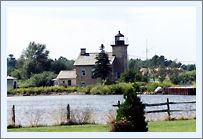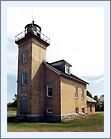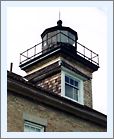 |
 |
 |
| Click thumbnails to view enlarged versions | ||
| Ontonagon Light | Seeing The Light |
|
|
|
|
Historical Information
In 1841, Michigan State geologist Douglas Houghton wrote an account of the boulder, and in the summer of 1843, Julius Eldred, a prospector from Detroit purchased the rock from the local Chippewa for the princely sum of one hundred and fifty dollars. Hearing of the sale, the Federal Government decided to lay claim to the boulder, and sold the rock that he had already purchased it to Eldred for thirteen hundred and sixty-five dollars. With great difficulty, Eldred hauled the rock to the river mouth with skids and rollers, where he was surprised to find representatives of the War Department awaiting him. With instructions to impound the rock and ship it to Washington, they delayed long enough to allow Eldred to hoist the rock onto the deck of a waiting schooner in the dead of night, and set sail down the lake. Eldred dragged the rock across the Sault portage, hoisted it onto another schooner and once again set down Lake Huron with his prize. Arriving in Detroit, Eldred placed the Ontonagon boulder on public display, charging a cash admission to curious onlookers. However, the government was not to be easily dissuaded, and once again claiming eminent domain, ordered that the boulder be shipped to Washington.
The legend of Ontonagon copper carried throughout the growing nation, and even to the courts of Europe. As a result, European nobility financed a number of copper mines in the Ontonagon area, with the Empress of Russia developing one and the Duke of Gloucester controlling another. Perhaps the most famous of Ontonagon's mines was the Minesota, which became renowned for its' lode of mass copper. It was here that the largest complete mass of native copper was ever found. With an estimated weight of five hundred tons, it netted the company one hundred and fifty thousand dollars. Mining in the area expanded rapidly, and vessel traffic in and out of Ontonagon harbor increased accordingly. Incoming vessels brought workers from Finland and Great Britain along with the supplies to support the growing community, while outbound vessels set sail from the harbor laden with copper.
As part of a system-wide upgrading process, the Lewis lamps were removed from the station's lantern room in 1857, and replaced with a Fifth Order Fresnel lens at a cost of $600. In 1860, the Army Corps of Engineers made significant improvements to the harbor, a major component of which was the construction of two piers flanking the dredged and widened river entrance. When complete, the east pier was seven hundred feet in length and the west pier stood at six hundred and fifty feet.
A story and a half structure, with an integrated thirty-four foot tall square tower at the western end, the cast iron spiral staircase within the tower providing access to the basement beneath the dwelling, the first and second floors, and to the lantern room itself.
Original estimates of standing pine were estimated at 4,000,000,000 board feet, and while there were some early logging operations, it was not until the Ontonagon Lumber Company began large-scale logging and milling in 1881 that lumbering began in the area in earnest. Capitalized at a total cost of a quarter million dollars, the operation purchased thirteen thousand acres of pine forest and began producing at a daily output of two hundred thousand board feet of lumber and three hundred thousand shingles.
Ontonagon once again found itself in a major boom period, and the Army Corps of Engineers undertook a series of harbor improvements to support the huge number of vessels using the harbor. The two filled wooden crib piers were extended, and the river entrance was dredged to greater depth. The lighthouse was now too far from the harbor entry to safely guide vessels between the extended piers, and a hexagonal timber pierhead light was installed at the end of the west pier. In order to keep costs low, responsibility for operation of this new pierhead light was added to the list of duties of the Ontonagon lighthouse keeper. Over the years, this process was continued, and with each pier extension, wave action along the outside of the western pier deposited sand along the pier, in effect moving the shoreline and the river mouth further out to sea. As a result, over time the Light station appeared to be located further and further inland In 1890, a square single-story brick kitchen was added to the eastern fašade of the light station building, and the station took on the appearance that still can be seen to this day.
Eyewitness accounts recall that "Smoldering forest fires had burned in the swamp south of the Diamond Match Co.'s big mills for two weeks. At noon the wind freshened. At I o'clock the first mill caught fire, despite a fire department creditable to the town, and of the special firemen and apparatus of the Diamond Match Co. The west side mill speedily became a seething mass of flames. The automatic sprinklers deluged the whole interior with water, but the gale from the southwest drove the flames into the lumber along the river, where 60,000,000 feet of pine lumber was stacked in piles as high as a three-story building. "The fire leaped across the river from the lumber and attacked the second mill, the planing mill of the Match Co., and the towering lumber piles stacked along the eastern banks. From there on it was a race for life. Quickly the flames spread. The firemen were compelled to abandon their apparatus and flee for their lives."
While relief efforts came from far and wide, the entire city was left a charred mess. With the surrounding forests burned to a crisp and copper price still too low to justify the reactivation of the mines, Ontonagon was destined never to regain its' glory of the early nineties. Use of the lighthouse was discontinued in April 1963 after an automatic foghorn and battery-powered, light were installed at the end of the east pier. The lighthouse was officially closed in January 1964, and the building was leased as a residence to its' last keeper Arnold Huuki and his wife. A Coast Guard crew removed the Fifth Order Fresnel from the tower, and presented it to the Ontonagon Historical Society, where it remains proudly displayed to this day.
By way of an epilogue, soon after it's
removal to Washington, Government geologists conducted a complete
analysis of the Ontonagon Boulder. After deliberation, it was determined
that the total value of Its' copper content was a mere six hundred
dollars! We stopped-off across the river and took the photograph on the left, assuming that it would be the only shot that we would get, and then drove into town to visit the Historical Society. Arriving at the museum, we struck-up a conversation with John, the curator, and found that from time-to-time he takes people for guided tours of the building. Since there were two former residents of Ontonagon who also wished to see the lighthouse, he suggested that we follow him with our vehicle, and he would get us into the lighthouse.
After a winding trip through pulp mill property we found out that the
building is being used for Coast Guard storage, but the Historical
Society is attempting to lease the property to serve as a museum, if
they can work out a safe access route with the pulp mill. The Ontonagon County
Historical Society gives two tours of the Lighthouse every day during
the summer. For information about these tours, contact the Society at
the address and phone number below. |